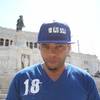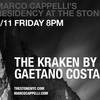"Pompeii Awakened": The Dead City that Still Speaks
In 1944, my father, George De Stefano Sr., was a U.S. Army sergeant stationed in southern
They, like many young men before and since, were eager to see one particular aspect of ancient Pompeian life: the dirty pictures. My father remembers visiting one building, which, based on his recollections, must have been the House of the Vetti, an opulent Pompeian home whose walls were decorated with X-rated erotic paintings. But the paintings were concealed behind wooden cabinets with locked doors. For a few lire, a worker would unlock the cabinet doors so my father and his friends could glimpse the shocking images.
When I visited Pompeii more than 50 years later, I could view the same murals without the peepshow obstructions. Moreover, the erotic art objects and artifacts that had been taken from Pompeii and long been kept from public view were on display, in an exhibition at the National Archaeological Museum in Naples called “The Secret Cabinet.”
The difference between my father’s and my experience of Pompeii is a modest metaphor for the subject of Judith Harris’ fascinating new book, Pompeii Awakened. Harris, a veteran American journalist who has lived in Italy for four decades, examines how the Western world has viewed Pompeii, the varied and shifting interpretations of the city and its civilization since its rediscovery in the mid-eighteenth century.
Harris observes that in the two and a half centuries since, “the dead city has never lost its uncanny power to fascinate.” More than two million tourists annually flock to Pompeii and nearby Herculaneum (Ercolano). Harris herself got the Pompeii bug when she was a
Enthralled by the novel, which culminates with the eruption of Vesuvius, she made her first “pilgrimage” to Pompeii as a student. Throughout her career, which has included reporting and commentary for RAI, the Wall Street Journal, Time and the BBC, Harris never lost her fascination with Pompeii, and her cultural history draws upon extensive research. She has interviewed “hundreds of archeologists, classicists, Pompeian scholars and cultural heritage administrators” in addition to visiting
Pompeii, the birthplace of scientific archeology, has been the testing ground for every discovery and error in the field. New studies of pollen, skeletal DNA, charred plants and even fecal matter left by the Pompeians build upon but also contradict older discoveries. But Pompeii isn’t just about those who once lived there – it is also the story of those who rediscovered the city, the “creative people from all over the world...who devoted their talents, fortunes and their lives…in order to reclaim
“Patron and poet, architect and priest, strumpet and queen,” they studied and recreated the site “in their imaginations, for ours, ringing changes in the arts, society, politics, ideas, and the very look of our homes and cities, from wallpaper to the Wedgwood ceramic candy box on the table.”
When Pompeii was rediscovered in the 18th century, “educated
“To historians, archeologists and scientists,” Harris explains, “Pompeii’s significance lies in its offering a total picture of the ancient world, captured at a single point in time. Other ancient cities, such as
From the moment of its rediscovery,
Harris evokes the stunning impact of Pompeian erotica on Christian Europe:
Although the 18th-century erudites were familiar with risqué ancient poetry, and possibly had seen vases with obscene motifs and the wall paintings of Etruscan tombs…nothing like this had ever been seen, and surely not in such quantity. From the ruins emerged both mildly erotic and blatantly pornographic scenes, painted on walls and on vases, designed in mosaic tiles on floors, vulgarly scribbled onto street-front walls.
Pompeian erotic art included “gigantic free-standing phalluses,” platters decorated with homosexual group sex scenes, and sculptures of Pan having intercourse with a she-goat. “In discoveries that to this day condition the attitudes toward
But awakened Pompeii spoke not only of sex and erotica; there were ideological and political lessons to be drawn from Vesuvian antiquity. For Johann Joachim Winckelmann, a politically radical, eighteenth century Prussian art historian, the Greek and Greek-inspired art found at
But no one made more ideological hay from Pompeii than the 20th century dictator who fancied himself a Caesar. In perhaps the book’s most compelling chapter, Harris describes how Benito Mussolini used antiquity for political propaganda, to justify militarism, war, and racism.
By the mid-1930s, Fascists “controlled all the tools of culture,” which was central to the regime’s power. “To build a totalitarian state,” Harris notes, “Mussolini had imposed harsh police measures and military controls. But without his cultural politics, this would not have sufficed in such a sophisticated country.” Control over
Mussolini’s handpicked administrator Amedeo Maiuri managed the sites at both Pompeii and Herculaneum. Even Maiuri’s opponents, Harris notes, praised his efforts to recover the sites in a systematic, scientific manner.
But, encouraged by Mussolini to “operate on a grand scale,” Maiuri got carried away and unnecessarily cut “great swathes” into the sites; buildings also would be stripped and allowed to decay while the best findings went to the Naples archaeological museum. The remainder were sold legally to foreign museums or illegally ended up in private collections.
“Mussolini’s overly aggressive excavation of Pompeii…in order to exploit archaeology as a propaganda tool…wreaked more destruction than all the Austrian captains of fortune, the arrogant Spanish, the drunken custodians of the early Risorgimento and the thieving bandits of Vesuvius.”
After World War II, Maiuri, the ultimate bureaucratic survivor, resumed his explorations. He triumphed with the excavation of a Greek library in the Villa of the Papyri at Herculaneum. The library, the only extant one from the ancient world, contained caches of papyrus scrolls. Harris provides an absorbing account of the contents of the fragile scrolls, philosophic works of prominent Stoics and Epicureans, as well as scientific texts and scripts of plays.
Vesuvian territory continues to be excavated. The latest and most important recovery is of a complex of buildings buried near the town of
If that were to occur, the results, Harris says, will be dire indeed: “As has happened for at least four millennia, all in its path will be entombed – people, first of all.” But despite government offers of compensation, inhabitants of towns and villages on the slopes of the volcano refuse to leave their homes. Harris finds one bright spot in this dark scenario: “advances in vulcanology should allow advance warning…Despite chaos, many will escape, as they have in the past. Even at
Buried and rediscovered many times, Pompeii and the other “lost cities of Vesuvius,” Harris concludes, continue to “haunt the imagination.” For anyone who has walked the stones of those ancient cities, and anyone who intends to someday, Pompeii Awakened is essential reading.





































i-Italy
Facebook
Google+
This work may not be reproduced, in whole or in part, without prior written permission.
Questo lavoro non può essere riprodotto, in tutto o in parte, senza permesso scritto.